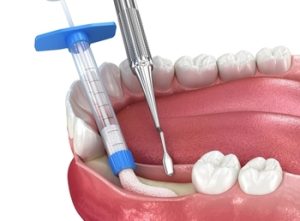One important factor often overlooked when considering dental implants is the need for bone grafting. For many, the idea of a simple tooth replacement procedure can quickly become more complicated once the condition of the jaw bone is assessed. If you’ve suffered from bone loss caused by missing teeth, gum disease, or other conditions, a bone graft might be required to guarantee the success of your dental implant procedure. But what does this mean for your wallet? In this blog, we’ll explore the cost of bone grafting for dental implants in Australia, how it works, and why it’s often an essential step in achieving a healthy smile.
What Exactly is a Bone Graft?
A bone graft is a surgical procedure where a piece of bone is transplanted to rebuild or strengthen areas where bone has been lost. In the case of dental implants, this is often done to restore the bone in the jaw, particularly when there isn’t enough bone to support the implant. Over time, bone loss can happen due to gum disease, tooth decay, and missing teeth. Without sufficient bone, the dental implant won’t have a sturdy foundation, increasing the risk of implant failure.
Bone grafting helps lay the groundwork for successful implant placement, ensuring the dental implant is secure and long-lasting. Based on the extent of bone loss, you may need different types of grafting, such as bone augmentation or a sinus lift for implants in the upper jaw.
Why is Bone Grafting Important for Dental Implants?
The good news is that once the graft is completed, your body will typically regenerate the transplanted bone over time, allowing it to become a strong foundation for your dental implant. Experienced dentists often recommend bone grafting to avoid complications in the long run, especially when considering multiple dental implants or implant-supported dentures.
How Much Does Bone Grafting Cost in Australia?
One of the most common questions patients ask is, “How much will a bone graft add to the overall cost of my dental implant treatment?” The cost can vary based on several factors, including the complexity of the procedure and the materials used. The cost of bone grafting for dental implants in Australia starts at approximately 500 AUD per site, with more complex procedures like a sinus lift potentially increasing the cost.
The national dental fee survey offers a rough estimate, but it’s important to consult your dental practice for a personalised quote. If you require multiple implants or grafting across different areas of the mouth, these costs will naturally increase.
What Influences the Cost of Bone Grafting?
Several factors can impact the cost of bone grafting and the overall dental implant cost in Australia:
- The extent of bone loss—The more severe the bone loss, the more complicated and expensive the grafting procedure.
- Type of Graft—The cost of using bone from your own body, a donor, or a synthetic material can be affected.
- Location of the Graft – Grafting in the upper or lower jaw may have different complexities, particularly if a sinus lift is involved.
- Dental Insurance Plans – While many dental insurance providers don’t cover the full dental implant cost, they may help with certain parts of the dental procedures, like grafting. Be sure to check your policy.
- Private Health Insurance—Depending on your coverage, private health insurance could significantly offset some of the costs.
- Experience of the Dentist – A more experienced dentist may charge higher fees for complex dental procedures like bone grafting.
How Bone Grafting Fits into the Overall Dental Implant Process
A typical dental implant procedure involves multiple stages, and if you need a bone graft, it usually occurs before the actual implant placement. Here’s a simplified breakdown:
- Initial Consultation – Your dentist will assess whether your jaw bone is strong enough to support an implant. If not, a bone graft will be recommended.
- Bone Graft Surgery – During the grafting procedure, bone material is added to your jaw. This may require a healing period of several months, during which the bone integrates with your natural bone.
- Dental Implant Placement – Once the graft has healed, the dentist will move on to the implant placement stage, inserting the artificial tooth root into your jaw.
- Replacement Tooth – After the implant has merged with the bone, a custom-made replacement tooth or crown is attached to the implant, completing the process.
Each stage adds to the dental implant cost, but the investment ensures a strong, functional, and long-lasting solution for missing teeth.
Recovery and Aftercare: What to Expect After Bone Grafting and Dental Implant Surgery
Once your bone grafting or dental implant surgery is complete, recovery is crucial to ensure the procedure’s success. Both processes require careful aftercare, but most patients find the recovery period manageable.
Recovery After Bone Grafting
If you undergo bone grafting, healing can take several months, depending on the size of the graft and the extent of the procedure. During this time, the grafted bone integrates with your natural jawbone, creating a solid foundation for the future dental implant. Here’s what you should do to promote healing:
- Avoid Pressure: Do your best to avoid putting pressure on the grafted area, especially during the first few weeks. Stick to soft foods and avoid chewing on the side of your mouth where the graft was done.
- Oral Hygiene: Keeping your mouth clean is crucial. Your dentist will provide specific guidelines, including gentle rinsing and perhaps prescribed mouthwash to avoid infection.
- Pain Management: Mild pain or discomfort is normal after a bone graft. Over-the-counter pain relief is usually sufficient, but always follow your dentist’s advice for medication use.
- Follow-Up Visits: Regular check-ups are vital to ensure the bone is integrating well. Your dentist may take X-rays to monitor the healing progress.
Recovery After Dental Implant Surgery
You can expect a similar recovery period following dental implant placement, especially during the osseointegration phase. This is when the implant fuses with the bone, a process that can take a few months. Here are some key aftercare tips:
- Rest: It’s important to take it easy in the first 24-48 hours after surgery. Avoid strenuous activity, as it could affect healing.
- Diet: Stick to a soft diet and avoid anything too hot, spicy, or hard. This will help protect the healing gum tissue and prevent unnecessary irritation.
- Oral Hygiene: Gentle brushing around the implant site is critical. Your dentist may recommend a special brush or mouthwash to help keep the area clean without disrupting healing.
- Monitor for Complications: While rare, infections or complications can arise. If you experience unusual swelling, ongoing pain, or signs of infection, reach out to your dentist right away.
Is Bone Grafting Painful?
The recovery period usually lasts a few weeks, during which time you’ll need to follow specific aftercare instructions to ensure the graft heals properly. Many patients report that the benefits far outweigh any temporary discomfort, as it allows them to proceed with their dental implant surgery successfully.
Will Dental Insurance Cover Bone Grafting?
The question of insurance coverage is always a crucial one. In Australia, many dental insurance plans do not cover cosmetic dentistry procedures like dental implants, but they might cover parts of the treatment, such as a basic tooth extraction or bone grafting if it’s deemed medically necessary. It’s important to consult with your private health insurance provider to clarify what is and isn’t covered.
For individuals without insurance, many dental practices offer payment plans, helping to manage the cost of dental implants and related treatments such as bone grafting.
Bone Grafting and Multiple Dental Implants
If you’re looking to replace several missing or damaged teeth with multiple dental implants, the need for bone grafts becomes even more critical. The more implants you need, the stronger your jawbone must be to support them. Multiple tooth implants require precise planning, and if your bone density isn’t sufficient, a bone graft will be necessary to ensure the success of the implant placement.
In some cases, patients may opt for implant-supported dentures, which also require a stable bone foundation. Whether you’re getting a single tooth implant or multiple implants, bone grafting can be the key to long-lasting success.
Alternative Options to Bone Grafting
While bone grafting is often the most reliable option for those with significant bone loss, some patients explore alternatives like traditional dental bridges or removable dentures. However, these options don’t offer the same level of permanence or function as dental implants. Advances in ceramic dental implants and other dental implant materials continue to make implants the preferred choice for many people seeking to replace lost teeth.
Different Types of Dental Implants
When considering dental implants, it’s essential to understand the various options available based on your specific needs. Each type is designed to address different situations, whether you are missing a single tooth or need to replace a full arch.
Single-Tooth Dental Implant
A single-tooth dental implant is the most common type of implant used when you need to replace just one missing tooth. This option is ideal for patients who have lost a tooth due to trauma, tooth decay, or other oral health issues. It can be used to:
- Replace a Missing Tooth: Whether the tooth was lost due to an accident or oral health issue, a single implant offers a permanent solution.
- Restore a Broken or Damaged Tooth: In cases where a tooth is too destructed to be repaired by traditional methods like crowns or fillings, a dental implant can regain the function and appearance of the tooth.
- Support an Existing Bridge or Denture: Implants can also be used to provide additional support for existing bridges, dentures, or partial dentures, offering improved stability and comfort.
Full-Arch Solution For Dental Implants
The Full-arch solution for dental implants is a popular option for patients who seek to replace an entire arch of teeth but want to avoid multiple implants. This procedure uses just four strategically placed implants to support an entire arch, making it quicker and less invasive than traditional full-mouth implants. This method is suitable for patients who have experienced bone loss but want to avoid extensive bone grafting. The benefits of full-arch solution dental implants include:
- Quicker and Less Invasive: With only four implants required to support an entire arch, the procedure is often faster and involves fewer surgeries.
- Stronger and More Stable: By using advanced techniques, the implants offer excellent stability and strength.
- Good for Jawbone Health: Since the implants are placed directly into the bone, they stimulate bone growth, improving long-term jawbone health.
- Ideal for Extensive Damage: This solution is particularly effective for patients with an extensively damaged dental arch due to disease or trauma.
Dental Implant-Supported Dentures
Implant-supported dentures offer a major improvement over traditional removable dentures. These dentures can either be clipped onto a permanently fixed implant bridge or be permanently attached themselves. Unlike conventional dentures, which may move around or cause discomfort, implant-supported dentures provide a stable, comfortable, and long-lasting solution. The key benefits include:
- Enhanced Stability: These dentures remain securely in place, preventing any shifting or slipping that often occurs with traditional dentures.
- Improved Comfort: Because they are supported by implants, these dentures feel more natural and comfortable in the mouth.
- Better Oral Health: Implant-supported dentures help maintain jawbone health, as the implants stimulate bone growth, unlike traditional dentures that can contribute to bone loss over time.
Which Type of Dental Implant is Right for You?
Choosing the right type of dental implant relies on your individual oral health needs and the condition of your teeth and jawbone. Whether you need a single dental implant or a complete full-arch solution, consulting with an experienced dentist is critical to determining the appropriate treatment plan for you.
For those with a single missing tooth, a single-tooth dental implant offers a natural and permanent replacement. Patients needing a full set of teeth replaced may benefit from either full-arch implants, also known as All-on-4 implants, depending on the extent of damage and their overall oral health. Finally, if you’re looking for a more stable, comfortable alternative to traditional dentures, implant-supported dentures provide a superior solution with long-lasting benefits.
By understanding the various types of dental implants and the benefits they offer, you can make a proper decision that will restore your smile and improve your quality of life.
Final Thoughts: Is Bone Grafting Worth the Investment?
Whether you’re replacing a single tooth or looking to restore your smile with multiple dental implants, bone grafting offers the support your implants need to function like natural teeth. While it may seem like a daunting addition to your dental treatment, the long-term benefits of having a secure, permanent solution to missing teeth make it worth the cost.
If you’re considering dental implants in Australia and need a bone graft, take comfort in knowing that you’re investing in a solution that offers strength, durability, and a return to the functionality of your natural teeth.
If you are considering dental implants and need consultation, contact Dr Jack Yang at (02) 8806 3712 and (02) 9000 1778.
Note: Any surgical or invasive procedure carries risks. Before proceeding, you should seek a second opinion from an appropriately qualified health practitioner.
References:
Cleveland Clinic. (n.d.). Dental bone graft. https://my.clevelandclinic.org/health/treatments/21727-dental-bone-graft
Body Expert. (n.d.). All-on-4. https://www.bodyexpert.online/en/all-on-4
Colgate. (n.d.). Implant-supported denture. https://www.colgate.com/en-us/oral-health/dentures/implant-supported-denture
WebMD. (n.d.). Dental crowns. https://www.webmd.com/oral-health/dental-crowns
Click4Teeth. (n.d.). What should I expect after dental implant treatment? https://www.click4teeth.com/feature-articles/what-should-i-expect-after-dental-implant-treatment/
Pothukuchi, A., & Chalavadi, P. (2022). Immediate dental implants in anterior esthetic region. Contemporary Clinical Dentistry, 13(Suppl 2), S142–S147. https://www.ncbi.nlm.nih.gov/pmc/articles/PMC9674049/












